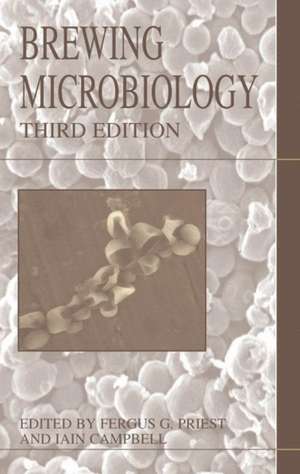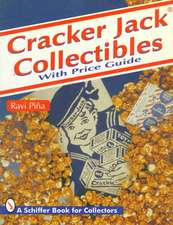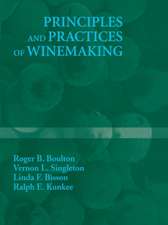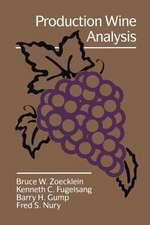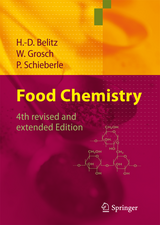Brewing Microbiology
Editat de F.G. Priest, Iain Campbellen Limba Engleză Hardback – 30 noi 2002
| Toate formatele și edițiile | Preț | Express |
|---|---|---|
| Paperback (1) | 1551.11 lei 6-8 săpt. | |
| Springer Us – 15 sep 2012 | 1551.11 lei 6-8 săpt. | |
| Hardback (1) | 1391.67 lei 6-8 săpt. | |
| Springer Us – 30 noi 2002 | 1391.67 lei 6-8 săpt. |
Preț: 1391.67 lei
Preț vechi: 1697.16 lei
-18% Nou
Puncte Express: 2088
Preț estimativ în valută:
266.28€ • 279.52$ • 221.03£
266.28€ • 279.52$ • 221.03£
Carte tipărită la comandă
Livrare economică 10-24 aprilie
Preluare comenzi: 021 569.72.76
Specificații
ISBN-13: 9780306472886
ISBN-10: 0306472880
Pagini: 399
Ilustrații: XII, 399 p. 9 illus.
Dimensiuni: 155 x 235 x 30 mm
Greutate: 0.75 kg
Ediția:3rd ed. 2003
Editura: Springer Us
Colecția Springer
Locul publicării:New York, NY, United States
ISBN-10: 0306472880
Pagini: 399
Ilustrații: XII, 399 p. 9 illus.
Dimensiuni: 155 x 235 x 30 mm
Greutate: 0.75 kg
Ediția:3rd ed. 2003
Editura: Springer Us
Colecția Springer
Locul publicării:New York, NY, United States
Public țintă
ResearchCuprins
1 Microbiological aspects of brewing.- Malting.- Brewing, mashing, and hop boiling.- Fermentation.- Postfermentation treatments.- Concluding remarks.- References.- 2 The biochemistry and physiology of yeast growth.- The cell cycle.- The growth and fermentation cycle.- Cell composition, nutrition, and general metabolism.- Energy and intermediary metabolism.- Yeast biochemistry and beer production.- Summary.- References.- 3 Yeast genetics.- Genetic features of Saccharomyces cerevisiae.- The need for new brewing yeasts.- Genetic techniques.- Application of recombinant DNA methods to brewing yeasts.- Molecular biological approaches to yeast differentiation.- The nature of the brewing yeast genome.- The commercial use of genetically modified brewing yeasts.- Conclusions.- Acknowledgment.- References.- 4 The microbiota of barley and malt.- The microbiota of barley.- The microbiota of malt.- Effects of microorganisms on malting.- Effects of the microbiota on beer and distilled spirit.- Health hazards.- Assessment of mold contamination.- References.- 5 Gram-positive brewery bacteria.- Lactic acid bacteria.- Lactobacillus.- Pediococcus.- Leuconostoc.- Homofermentative cocci.- Kocuria, Micrococcus and Staphylococcus.- Endospore-forming bacteria.- Identification of genera of Gram-positive bacteria of brewery origin.- Concluding remarks.- References.- 6 Gram-negative brewery bacteria.- Acetic acidbacteria.- Enterobacteriaceae.- Zymomonas.- Anaerobic Gram-negative rods.- Megasphaera.- Miscellaneous non-fermentative bacteria.- Detection, enumeration, and isolation.- Conclusions.- References.- 7 Wild yeasts in brewing and distilling.- Systematics of yeasts.- Properties for identification of yeasts.- Detection of wild yeasts.- Identification of wild yeasts.- Effects of wild yeasts in the brewery.- Elimination of wild yeasts.- References.- 8 Rapid detection and identification of microbial spoilage.- Impedimetric techniques (conductance, capacitance).- Microcalorimetry.- Turbidometry.- How cytometry.- ATP bioluminescence.- Microcolony method.- Direct epiflourescence filter technique (DEFT).- Chemscan.- Protein fingerprinting by polyacrylamide gel electrophoresis.- Karyotyping (chromosome fingerprinting).- Immunoanalysis.- Hybridization using DNA probes.- Polymerase chain reaction.- Random amplified polymorphic DNA PCR.- Summary.- Acknowledgments.- References.- 9 Rapid identification of microorganisms.- What is identification?.- Approaches to identification.- Nucleic acid-based identification.- Techniques for examining proteins.- Methods that examine aspects of cell composition.- Techniques for studying morphology and behavior.- Concluding remarks.- Acknowledgments.- References.- 10 Microbiology and sanitation in U.S. microbrewies.- The raw materials.- The process and product.- Beer contact surfaces.- Concluding remarks.- References.- 11 Cleaning and disinfection in the brewing industry.- Definitions.- Standards required in a brewery.- Cleaning methods available.- Soil composition.- Process of detergency.- Chemistry of detergents.- Caustic and alkaline detergents.- Sequestrants.- Acids.- Surface-active agents.- Disinfectants and sanitizers used in breweries.- Oxidizing disinfectants.- Nonoxidizing disinfectants.- Water treatment.- Steam.- Summary.- References.- 12 Microbiological methods in brewing analysis.- Microbiological analysis of raw materials.- Yeast.- Wort and fermentation.- Sterility of plant.- Beer.- Conclusions.- References.
